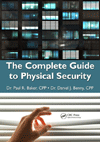On April 20, 1999, two Columbine, Colo. High School seniors, Eric Harris and Dylan Klebold, shot and killed 13 people — 12 students and a teacher — before turning their weapons on themselves.
The event marked the beginning of an era in which American citizens have repeatedly been forced to deal with the threat of school shootings. Since the Columbine High School shooting, more than 226,000 students at 233 schools have been impacted by school shootings, according to a Washington Post analysis. According to data from the US Naval Postgraduate School, there were 94 school gun violence incidents in 2018 — a record high since 1970, which is as far back as the data goes, and 59 percent higher than the previous record of 59 in 2006. Facing this reality, what can we do to minimize the risk and damage associated with an active shooter?
Many people have advocated for the deployment of metal detectors at schools, to ensure that students, staff, and visitors do not bring weapons or other metallic objects that may be used for harm onto the premises. While this is a viable option, and one that is used in some large school districts across the U.S., the decision to use them has always been controversial, for many reasons.
For example, following the shooting at Marjorie Stoneman Douglas High School on February 14, 2018, the school system said it would launch a pilot program with metal detectors at the school during the upcoming academic year. However, in August 2018, Broward County Public Schools announced it would delay the plan because of concerns regarding staffing, privacy and logistics.
“As we continue our due diligence to implement the program — consulting with vendors and experts — many issues have been raised that require the District to pause and have a more thoughtful discussion on policy and procedural aspects of this pilot,” Robert Runcie, the superintendent of Broward County Public Schools, wrote in a letter to Stoneman Douglas families.
Logistically, there are challenges with metal detectors when there are multiple entrances to a school, which is most often the case. If the school has even a single point of entry that is not protected by a metal detector, the entire school is compromised.
In addition, throughput is an issue when you are restricting entry to a school by placing metal detectors at certain entrances. By limiting the number of entry/exit points at your school, you are compelling all students, staff and visitors to go through those doors, often at specific times of the day. For example, in the morning when students are arriving, a crowd is likely to form at that entrance. Best practices require a space of three seconds between individuals passing through a metal detector, and that will likely cause traffic jams.
Furthermore, there are initial and ongoing costs associated with metal detectors. Each one must be staffed by several trained security personnel to ensure proper operation, check bags and conduct secondary screening, if necessary. Each individual must have ongoing training to ensure they know the most recent safety protocols. Additionally, you must decide whether you will staff the metal detectors for the full day (including after-school programs) or only during peak entry times. Equipment upkeep and maintenance of the metal detectors must also be considered, as well as eventual replacement, especially if they are located in an outdoor environment. Also, if the school or school district uses an access control system, then integrators and/or IT staff may need to complete an integration between the metal detectors, the visitor and incident management system and the access control system.
As school security and administration consider the viability of metal detectors, a solid security strategy to mitigate risks at the door is to ensure that your visitor management system effectively screens and tracks any individuals entering and leaving your school, and can help your team to successfully respond and communicate to internal teams as well as external authorities if a threat is found.
Integrations between software-based security systems should be a high priority for schools and school districts. If the installed security layers cannot communicate effectively, you may be left with gaps in coverage. For example, if schools leverage a cloud-based visitor and incident management system containing a watch list, that data can be pushed to other intelligent perimeter security systems - like facial recognition. If a watch-list match is found, then a threat notification can instantly be sent back to the visitor and incident management system triggering alert notifications to pre-determined stakeholders. If the threat is confirmed, then pre-determined stakeholders can instantly escalate the threat to a lockdown and notify all other stakeholders and authorities in near real-time.
Metal detectors can also be integrated with visitor and incident management systems, and once a threat is identified, alert notifications can be sent for verification and possible escalation. Visitor and incident management systems should be integrated with access control platforms so that additional safety measures can be taken – like locking doors, changing signage, audible alarms/sirens, and more.
Your visitor management system should also integrate with incident management systems, so that if there is a visitor-related threat or emergency incident, the system will invoke the incident management system (i.e., the virtual alarm system) and send out silent, immediate, mass notifications to mitigate or completely stop an attack.
It’s also crucial for any person “on the front line” of your school (i.e., SRO, Police Officer, or a staff member) to be in contact with the authorities who are coordinating any type of response, and that they remain calm and not let the potential perpetrator know that they have been identified as a threat. Here, a visitor management system can offer two-way communication that enables all involved parties to communicate silently, helping to ensure that the incident does not escalate.
To be effective, two-way communications must reach their target and be seen. However, many people have become conditioned to ignore the overload of beeps, pings and other notifications we get from our devices constantly. Therefore, a school visitor and incident management system must be able to send stakeholders mass notifications across multiple communication methods including email, text (SMS), mobile push notifications and web (computer-based) push notifications – otherwise we take the risk that someone important may not be notified. Any visitor and incident management system that does not include all four of these communication methods is not adequate.
Many schools do embrace metal detectors, but they are not a standalone technology solution. Instead, look for an integrated visitor and incident management system that will not only verify the identity and background of any potential visitor that enters your facility, but also will improve incident and lockdown response time.










